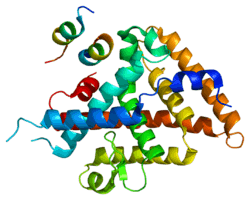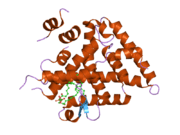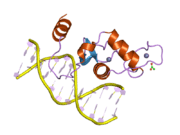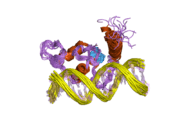Liver receptor homolog-1
The liver receptor homolog-1 (LRH-1) also known as NR5A2 (nuclear receptor subfamily 5, group A, member 2) is a protein that in humans is encoded by the NR5A2 gene.[5][6] LRH-1 is a member of the nuclear receptor family of intracellular transcription factors.
LRH-1 plays a critical role in the regulation of development, cholesterol transport, bile acid homeostasis and steroidogenesis.[7][8][9]
LRH-1 is important for maintaining pluripotence of stem cells during embryonic development.[10]
Interactions
Liver receptor homolog-1 has been shown to interact with the small heterodimer partner.[11][12]
gollark: I think it will soon be able to autocraft microchips.
gollark: Mine better.
gollark: It's just annoying, because it seems to just vanish into oblivion.
gollark: I know that.
gollark: Okay, so I seem to have autolost my autocrafting output. Again. Where is it going?
References
- GRCh38: Ensembl release 89: ENSG00000116833 - Ensembl, May 2017
- GRCm38: Ensembl release 89: ENSMUSG00000026398 - Ensembl, May 2017
- "Human PubMed Reference:". National Center for Biotechnology Information, U.S. National Library of Medicine.
- "Mouse PubMed Reference:". National Center for Biotechnology Information, U.S. National Library of Medicine.
- Bernier D, Thomassin H, Allard D, Guertin M, Hamel D, Blaquière M, Beauchemin M, LaRue H, Estable-Puig M, Bélanger L (Mar 1993). "Functional analysis of developmentally regulated chromatin-hypersensitive domains carrying the alpha 1-fetoprotein gene promoter and the albumin/alpha 1-fetoprotein intergenic enhancer". Molecular and Cellular Biology. 13 (3): 1619–33. doi:10.1128/mcb.13.3.1619. PMC 359474. PMID 7680097.
- Galarneau L, Drouin R, Bélanger L (1998). "Assignment of the fetoprotein transcription factor gene (FTF) to human chromosome band 1q32.11 by in situ hybridization". Cytogenetics and Cell Genetics. 82 (3–4): 269–70. doi:10.1159/000015116. PMID 9858833.
- Fayard E, Auwerx J, Schoonjans K (May 2004). "LRH-1: an orphan nuclear receptor involved in development, metabolism and steroidogenesis". Trends in Cell Biology. 14 (5): 250–60. doi:10.1016/j.tcb.2004.03.008. PMID 15130581.
- Luo Y, Liang CP, Tall AR (Jul 2001). "The orphan nuclear receptor LRH-1 potentiates the sterol-mediated induction of the human CETP gene by liver X receptor". The Journal of Biological Chemistry. 276 (27): 24767–73. doi:10.1074/jbc.M100912200. PMID 11331284.
- Nitta M, Ku S, Brown C, Okamoto AY, Shan B (Jun 1999). "CPF: an orphan nuclear receptor that regulates liver-specific expression of the human cholesterol 7alpha-hydroxylase gene". Proceedings of the National Academy of Sciences of the United States of America. 96 (12): 6660–5. doi:10.1073/pnas.96.12.6660. PMC 21971. PMID 10359768.
- Gu P, Goodwin B, Chung AC, Xu X, Wheeler DA, Price RR, Galardi C, Peng L, Latour AM, Koller BH, Gossen J, Kliewer SA, Cooney AJ (May 2005). "Orphan nuclear receptor LRH-1 is required to maintain Oct4 expression at the epiblast stage of embryonic development". Molecular and Cellular Biology. 25 (9): 3492–505. doi:10.1128/MCB.25.9.3492-3505.2005. PMC 1084298. PMID 15831456.
- Brendel C, Schoonjans K, Botrugno OA, Treuter E, Auwerx J (Sep 2002). "The small heterodimer partner interacts with the liver X receptor alpha and represses its transcriptional activity". Molecular Endocrinology. 16 (9): 2065–76. doi:10.1210/me.2001-0194. PMID 12198243.
- Lee YK, Moore DD (Jan 2002). "Dual mechanisms for repression of the monomeric orphan receptor liver receptor homologous protein-1 by the orphan small heterodimer partner". The Journal of Biological Chemistry. 277 (4): 2463–7. doi:10.1074/jbc.M105161200. PMID 11668176.
Further reading
- Wong M, Ramayya MS, Chrousos GP, Driggers PH, Parker KL (Oct 1996). "Cloning and sequence analysis of the human gene encoding steroidogenic factor 1". Journal of Molecular Endocrinology. 17 (2): 139–47. doi:10.1677/jme.0.0170139. PMID 8938589.
- Li M, Xie YH, Kong YY, Wu X, Zhu L, Wang Y (Oct 1998). "Cloning and characterization of a novel human hepatocyte transcription factor, hB1F, which binds and activates enhancer II of hepatitis B virus". The Journal of Biological Chemistry. 273 (44): 29022–31. doi:10.1074/jbc.273.44.29022. PMID 9786908.
- Nitta M, Ku S, Brown C, Okamoto AY, Shan B (Jun 1999). "CPF: an orphan nuclear receptor that regulates liver-specific expression of the human cholesterol 7alpha-hydroxylase gene". Proceedings of the National Academy of Sciences of the United States of America. 96 (12): 6660–5. doi:10.1073/pnas.96.12.6660. PMC 21971. PMID 10359768.
- Goodwin B, Jones SA, Price RR, Watson MA, McKee DD, Moore LB, Galardi C, Wilson JG, Lewis MC, Roth ME, Maloney PR, Willson TM, Kliewer SA (Sep 2000). "A regulatory cascade of the nuclear receptors FXR, SHP-1, and LRH-1 represses bile acid biosynthesis". Molecular Cell. 6 (3): 517–26. doi:10.1016/S1097-2765(00)00051-4. PMID 11030332.
- Wang ZN, Bassett M, Rainey WE (Oct 2001). "Liver receptor homologue-1 is expressed in the adrenal and can regulate transcription of 11 beta-hydroxylase". Journal of Molecular Endocrinology. 27 (2): 255–8. doi:10.1677/jme.0.0270255. PMID 11564608.
- Zhang CK, Lin W, Cai YN, Xu PL, Dong H, Li M, Kong YY, Fu G, Xie YH, Huang GM, Wang Y (Aug 2001). "Characterization of the genomic structure and tissue-specific promoter of the human nuclear receptor NR5A2 (hB1F) gene". Gene. 273 (2): 239–49. doi:10.1016/S0378-1119(01)00586-8. PMID 11595170.
- Lee YK, Moore DD (Jan 2002). "Dual mechanisms for repression of the monomeric orphan receptor liver receptor homologous protein-1 by the orphan small heterodimer partner". The Journal of Biological Chemistry. 277 (4): 2463–7. doi:10.1074/jbc.M105161200. PMID 11668176.
- Clyne CD, Speed CJ, Zhou J, Simpson ER (Jun 2002). "Liver receptor homologue-1 (LRH-1) regulates expression of aromatase in preadipocytes". The Journal of Biological Chemistry. 277 (23): 20591–7. doi:10.1074/jbc.M201117200. PMID 11927588.
- Brendel C, Gelman L, Auwerx J (Jun 2002). "Multiprotein bridging factor-1 (MBF-1) is a cofactor for nuclear receptors that regulate lipid metabolism". Molecular Endocrinology. 16 (6): 1367–77. doi:10.1210/mend.16.6.0843. PMID 12040021.
- Sirianni R, Seely JB, Attia G, Stocco DM, Carr BR, Pezzi V, Rainey WE (Sep 2002). "Liver receptor homologue-1 is expressed in human steroidogenic tissues and activates transcription of genes encoding steroidogenic enzymes". The Journal of Endocrinology. 174 (3): R13–7. doi:10.1677/joe.0.174R013. PMID 12208674.
- Sablin EP, Krylova IN, Fletterick RJ, Ingraham HA (Jun 2003). "Structural basis for ligand-independent activation of the orphan nuclear receptor LRH-1". Molecular Cell. 11 (6): 1575–85. doi:10.1016/S1097-2765(03)00236-3. PMID 12820970.
- Privalsky ML (Jul 2003). "Activation incarnate". Developmental Cell. 5 (1): 1–2. doi:10.1016/S1534-5807(03)00196-5. PMID 12852843.
- Fayard E, Schoonjans K, Annicotte JS, Auwerx J (Sep 2003). "Liver receptor homolog 1 controls the expression of carboxyl ester lipase". The Journal of Biological Chemistry. 278 (37): 35725–31. doi:10.1074/jbc.M302370200. PMID 12853459.
- Annicotte JS, Fayard E, Swift GH, Selander L, Edlund H, Tanaka T, Kodama T, Schoonjans K, Auwerx J (Oct 2003). "Pancreatic-duodenal homeobox 1 regulates expression of liver receptor homolog 1 during pancreas development". Molecular and Cellular Biology. 23 (19): 6713–24. doi:10.1128/MCB.23.19.6713-6724.2003. PMC 193920. PMID 12972592.
- Peng N, Kim JW, Rainey WE, Carr BR, Attia GR (Dec 2003). "The role of the orphan nuclear receptor, liver receptor homologue-1, in the regulation of human corpus luteum 3beta-hydroxysteroid dehydrogenase type II". The Journal of Clinical Endocrinology and Metabolism. 88 (12): 6020–8. doi:10.1210/jc.2003-030880. PMID 14671206.
- Cai YN, Zhou Q, Kong YY, Li M, Viollet B, Xie YH, Wang Y (Dec 2003). "LRH-1/hB1F and HNF1 synergistically up-regulate hepatitis B virus gene transcription and DNA replication". Cell Research. 13 (6): 451–8. doi:10.1038/sj.cr.7290187. PMID 14728801.
- Saxena D, Safi R, Little-Ihrig L, Zeleznik AJ (Aug 2004). "Liver receptor homolog-1 stimulates the progesterone biosynthetic pathway during follicle-stimulating hormone-induced granulosa cell differentiation". Endocrinology. 145 (8): 3821–9. doi:10.1210/en.2004-0423. PMID 15117876.
External links
- NR5A2+protein,+human at the US National Library of Medicine Medical Subject Headings (MeSH)
This article is issued from Wikipedia. The text is licensed under Creative Commons - Attribution - Sharealike. Additional terms may apply for the media files.









